This is Oyster Bay
|
This article first appeared in |
| Written and photographed by: Thomas Hauerslev | Issue 51 - December 1997 |
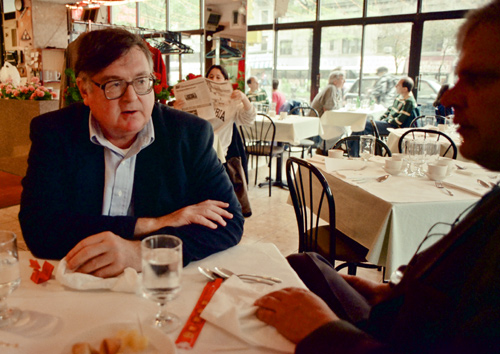 Meeting
John Belton in New York Meeting
John Belton in New YorkThis article ends the three-part account of the "Cinerama Holiday" Get Together in Dayton, the "Historical Wide Screen Gathering" in Southbridge and the visit to the birthplace of Cinerama. We end the tour in New York for the grand finale: a visit to Oyster Bay where The Cinerama headquarters was located. Willem and I arrived in New York by train at Grand Central Station. At the platform to welcome us was Mr. Dennis Furbush, who we had met a few days earlier in Dayton. We were his guests over the week-end in Jackson Heights. Our visit to New York was going to be a short visit with many things on our agenda. Saturday: Sightseeing in New York City. Sunday: Oyster Bay. Monday: Radio City Music Hall. |
Further in 70mm reading: |
 Oyster
Bay tennis court interior. Click to see enlargement Oyster
Bay tennis court interior. Click to see enlargementAs Saturday dawned it was raining. Willem and John Belton had arranged a meeting in a restaurant on Broadway and 90th at 2 PM. The subway took us directly to Times Sq and 42nd street. Willem and I spent the entire morning on Broadway looking for the old cinemas. We passed The Broadway Theatre where "This is Cinerama" opened. The theatre is still open as a live venue and is currently running "Miss Saigon". The second Cinerama theatre on Times Sq, The Warner Theatre, had been demolished a long time ago. We passed the site where The Rivoli once stood and where "Oklahoma!" in Todd-AO opened. That cinema had been demolished in the eighties and is now replaced by a black monolith building. Lunch was within reach of us and we finally met John Belton in a chinese restaurant. John was all ears when we told him about our Widescreen Activities of the past week. The next day we were going to find the old Cinerama headquarters in Oyster Bay on Long Island. John was sorry he couldn't go, but he was too busy with work. Sunday morning was a beautiful day with sunshine from a clear blue sky. Richard C. Babish arrived at 10 am at Dennis Furbush's apartment. After formal introductions we drove off towards Oyster Bay. During the 90 minute drive Dick Babish thrilled us with stories about Vitarama and Cinerama. In 1942 he installed The Waller Gunnery Trainer in several places in the US and Hawaii. He later served as optical engineer and vice president of Vitarama. He was Research & Development Engineer for Cinerama and technical advisor on "This is Cinerama" and "Cinerama Holiday". He holds several Cinerama patents. |
|
 Oyster
Bay tennis court exterior, 8 Pond Place. Oyster
Bay tennis court exterior, 8 Pond Place.After driving around looking for the address we finally found Woodward leading up to Pond Place, and then, number 8. Bingo! Here it was. I felt the history of wide screen blowing in the winds. Thanks to the vision of Fred Waller, it was here Cinerama took shape. This is where the mother of all super wide screen film formats was born. A simple idea of re-creating human vision in the cinema was transformed into a very complex first person film presentation system in this very house! Amazing to believe. So many years ago, this place was a beehive of creative people. Musicians, engineers, projection experts, sound experts and movie hot-shots. The day we arrived, Sunday May 4, 1997, everything was absolutely quiet. There was no trace left of any film activities, except 4 crazy, but very happy, wide screen enthusiasts walking around the building taking pictures. I am sure if any representatives from the police community had seen us, they would have asked us serious questions about what was going on. It must have been their day off... we were not arrested. |
|
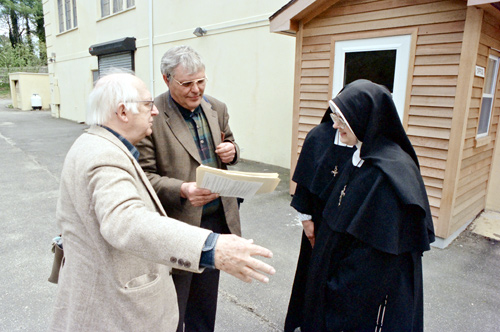 Oyster
Bay, Dick Babish and Willem Bouwmeester convincing two nuns it's OK to get
in to see where Cinerama was born. Oyster
Bay, Dick Babish and Willem Bouwmeester convincing two nuns it's OK to get
in to see where Cinerama was born.The next question was simple: How do we get inside the tennis court? We did not come all the way from Europe to not get inside! Willem and Dick Babish met two people living there. It turned out to be a convent of Daughters of Mary St. Pius V Chapel, offering a Sunday traditional latin mass. I didn't feel any specific need for a latin mass that morning and I just asked for the tour inside, please. After a few minutes of asking, they let us in. Armed with cameras, a wealth of questions and a stack of stills, we all humbly entered the building. Inside the tennis court were a temporary office, a tent, several cars, 2 basketball baskets, a wide selection of chairs and endless boxes with the belongings of the convent. They excused the mess inside as they were using the tennis court as storage room for the time being. Of course we didn´t mind at all. Once inside, I believe we all preferred the mess instead of the mass. |
|
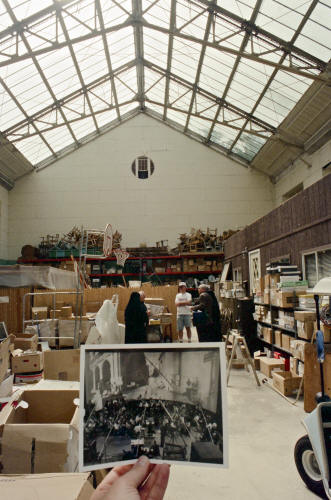 Oyster
Bay tennis court interior. Click to see enlargement Oyster
Bay tennis court interior. Click to see enlargementImagine a simple tennis court with walls on all sides and a glass roof to let in daylight. That is really it. (Editors note: Look for a 4-second cut of a similar indoor tennis court in the main titles of "Sabrina" (1996)). To access the tennis court, there is a door leading to the Convent gift shop and the library. 45 years ago it led to the sound room where all dubbers were. Willem and I examined the room carefully and looked at old stills to find out where things had been. There is a balcony and several windows. In one end of the tennis court Fred Waller installed the Cinerama screen, several of which were experimental. Three projection rooms A, B and C were installed in the opposite end of the court. Below Baker, a standard 35mm projection room took up space. In the middle were a wide selection of recording booms, a 60 piece Cinerama orchestra, loads of electrical units like recorders and mixers. Willem showed the sisters old black and white stills taken in the fifties. It was easy to imagine where the screen and projectors had been. The sisters had no idea of the cinematic past of their tennis court. They had never heard of Cinerama. They were surprised to see all the stills of the place and what it used to look like. They made photocopies of some of the pictures for their library. I assured both sisters the tennis court is a "holy" place for many Cinerama enthusiasts. They both smiled and seemed to enjoy the international visit. |
|
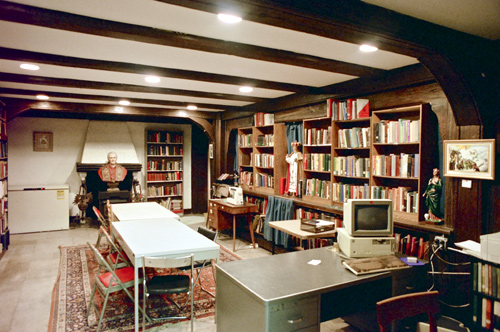 Oyster
Bay library. Oyster
Bay library.The visit brought back many fond memories of Fred Waller, Vitarama and Cinerama. Dick Babish showed us where he ran 3-strip camera tests. He had brought some of the original camera negatives along to illustrate. Camera tests were also carried out outside the tennis court. Once the tour was over, sisters and movie buffs all lined up outside for the traditional group shot in memory of the visit. |
|
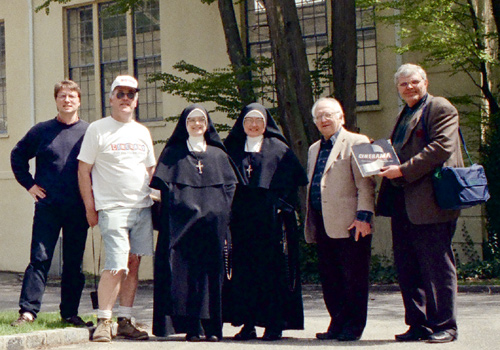 Oyster
Bay group pictures with Thomas, Dennis, nun, nun, Dick and Willem. Oyster
Bay group pictures with Thomas, Dennis, nun, nun, Dick and Willem.What was it like to see? Well, it was amazing to see it. Or, actually, what was there to see? Nothing, really! I knew the building from pictures. It is a big yellow 3-story building surrounded by trees, with a parking lot outside. An automatic door and a small office has been added to the facade, but otherwise it looked as it did 50 years ago. The building looked as if it was in pretty good condition. The Indoor Tennis Court is not your average Studio Tour. It is completely different, and probably less than a handful of people would ever dream of visiting it. First of all, there is no film to see anywhere! But from a historical point of view it is interesting to see where a chapter in wide screen history was written. I am happy to have seen it. We thanked the Daughters of Mary St. Pius V Chapel for their hospitality. Maybe they should consider putting a plaque on the wall telling everyone this is were Cinerama was born. |
|
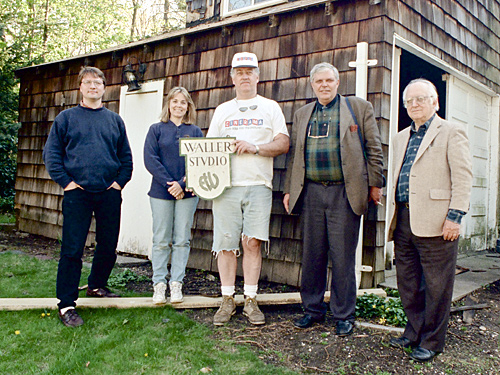 Thomas
Hauerslev, Catherine Monroe, Dennis Furbush, Willem Bouwmeester and Dick
Babish. Image by Thomas Hauerslev Thomas
Hauerslev, Catherine Monroe, Dennis Furbush, Willem Bouwmeester and Dick
Babish. Image by Thomas HauerslevThe same afternoon we visited the home of Fred Waller in nearby Huntington. His granddaughter, Kathrin Monroe, her husband and their son are living in Waller's house. After presenting ourselves and almost being eaten by their dog, Mrs. Monroe invited us inside for some liquid refreshments. We told her about the visit to the tennis court and why we came from Europe to do that. Pure enthusiasm and love for the history of movies. |
|
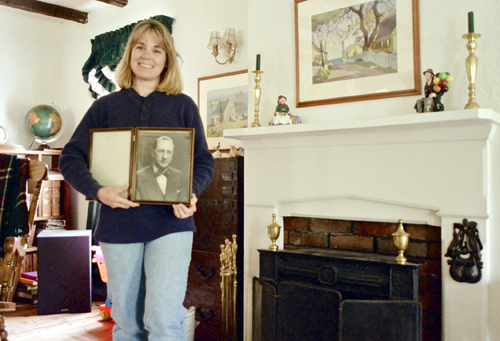 Mrs.
Catherine Monroe (Now Clarke) holding Fred Waller's portrait. Image by
Thomas Hauerslev Mrs.
Catherine Monroe (Now Clarke) holding Fred Waller's portrait. Image by
Thomas HauerslevAlso see Cinerama Test Shots Mrs. Monroe never met her famous grandfather Fred Waller, but knew his history very well. Mrs. Monroe was very pleasant young woman and quite surprised to have her house invaded by 4 Cinerama enthusiasts on a Sunday afternoon! She was especially happy to meet Dick Babish, who had worked closely with Fred Waller and who knew her house from visits 50 years earlier. Behind her house, was Fred Waller's old barn a.k.a. Waller Stvdio. In this barn all Waller's ideas took form. Water-skis, The Gunnery Trainer, Photometric Fit Picture and Cinerama. Until recently, the barn was in very poor shape after 40 years of non-use. It was more or less untouched by the late Mrs. Waller since Fred Waller died in 1954. 40 years of decay finally ended last year when the Monroes began to restore the barn. Before we left I took the traditional Everybody Line Up, please picture in front of the "Waller Stvdio". It had been a memorable day in Oyster Bay and a moving conclusion to our US visit. Not only did we see the place of the event, Fred Waller's house and studio, but we also met Mrs. Kathrin Monroe, granddaughter of Fred Waller. |
|
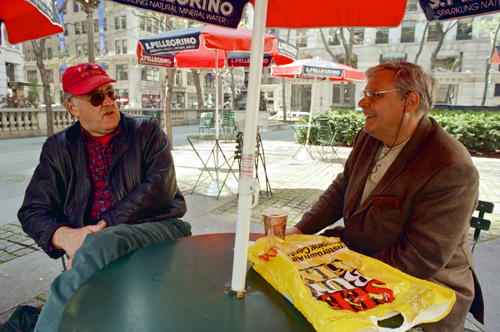 Dennis
and Willem in New York. Dennis
and Willem in New York.On our way back to New York, we went looking for the first purpose-built Todd-AO cinema. It had opened in Syosset in 1956. We found, to my great disappointment, the United Artists Theatre Circuit had demolished a theatre here a few years ago which could be the one we were looking for. The demolished cinema had Cinerama and Dimension 150 installed. It was gone today along with its DP70s. Finally back in New York, we said goodbye to Dick Babish, who still had a 90 minute drive ahead of him. The following day, Dennis and I visited Radio City Music Hall while Willem went to visit the widow of Nicolas Resini. Once was the owner of Cinerama, Inc. But that is another story. Wednesday morning I was back in Copenhagen. My suitcase was full of notes, film clips and many other historical souvenirs. Many individuals gave their time, help, support, assistance and hospitality during the visit. To all who assisted us, I remain forever grateful. |
|
| Go: back
- top - back issues Updated 22-01-25 |
